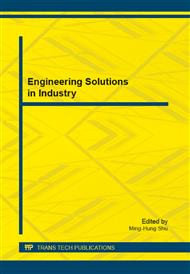[1]
D.R. Clarke, Vristor ceramics. J. Am. Ceram. Soc. 82 (1999), 485.
Google Scholar
[2]
T.K. Gupta, Application of zinc oxide varistors. J. Am. Ceram. Soc. 73 (1990), 1817.
Google Scholar
[3]
J. Fan, P. Poosimma, R. Freer, The Phase Development of ZnO varistor, accepted to be published on Advances in Applied Ceramics, (2014).
Google Scholar
[4]
J. Fan, R. Freer: Electrical properties and DC degradation characteristics of Ag doped ZnO varistors. J. Mater. Sci. 28 (1993), 1391.
DOI: 10.1007/bf01191983
Google Scholar
[5]
J. Fan, R. Freer: Improvement of the non-linearity and degradation behavior of ZnO various by combined Al and Ag doping. Br. Ceram. Trans. 92 (1993), 221.
Google Scholar
[6]
J. Fan, R. Freer: The Roles Played by Ag and Al Dopants in Controlling the Electrical Properties of ZnO Varistors, J. Appl. Phys. 77 (1995), 4795.
DOI: 10.1063/1.359398
Google Scholar
[7]
H. Satoh, et al: Effect of Cu-doping on II-VI semiconducting ZnO. Ferroelectrics. 264 (2001), 139.
Google Scholar
[8]
Z. Zhou, et al., Effects of dopants and hydrogen on the electrical conductivity of ZnO, J. Euro. Ceram. Soc., 24 (2004), 139.
Google Scholar
[9]
N. Raghu, T. R. N. Kutty, The influence of dislocations on the nonlinearity of ZnO: Cu varistors, J. Mater. Sci: Materials in Electronics, 1 (1990), 84.
DOI: 10.1007/bf00694912
Google Scholar
[10]
N B. S. Chiou, M. C. Chung, Effect of copper additives on the microstructure and electrical properties of polycrystalline zinc oxide, J. Am. Ceram. Soc., 75 (1992), 3363.
Google Scholar
[11]
J. Fan, et al., The Effects of Cu Dopant on the Microstructure and Non-ohmic Electrical Properties of ZnO Varistors, Advanced Materials Research, 343-344 (2012), 160.
DOI: 10.4028/www.scientific.net/amr.343-344.160
Google Scholar
[12]
T. K. Gupta, A. C. Miller, Improved Stability of the ZnO Varistor via Donor and Acceptor Doping at the Grain-boundary, J. Mater. Res. 3 (1988), 745.
DOI: 10.1557/jmr.1988.0745
Google Scholar


